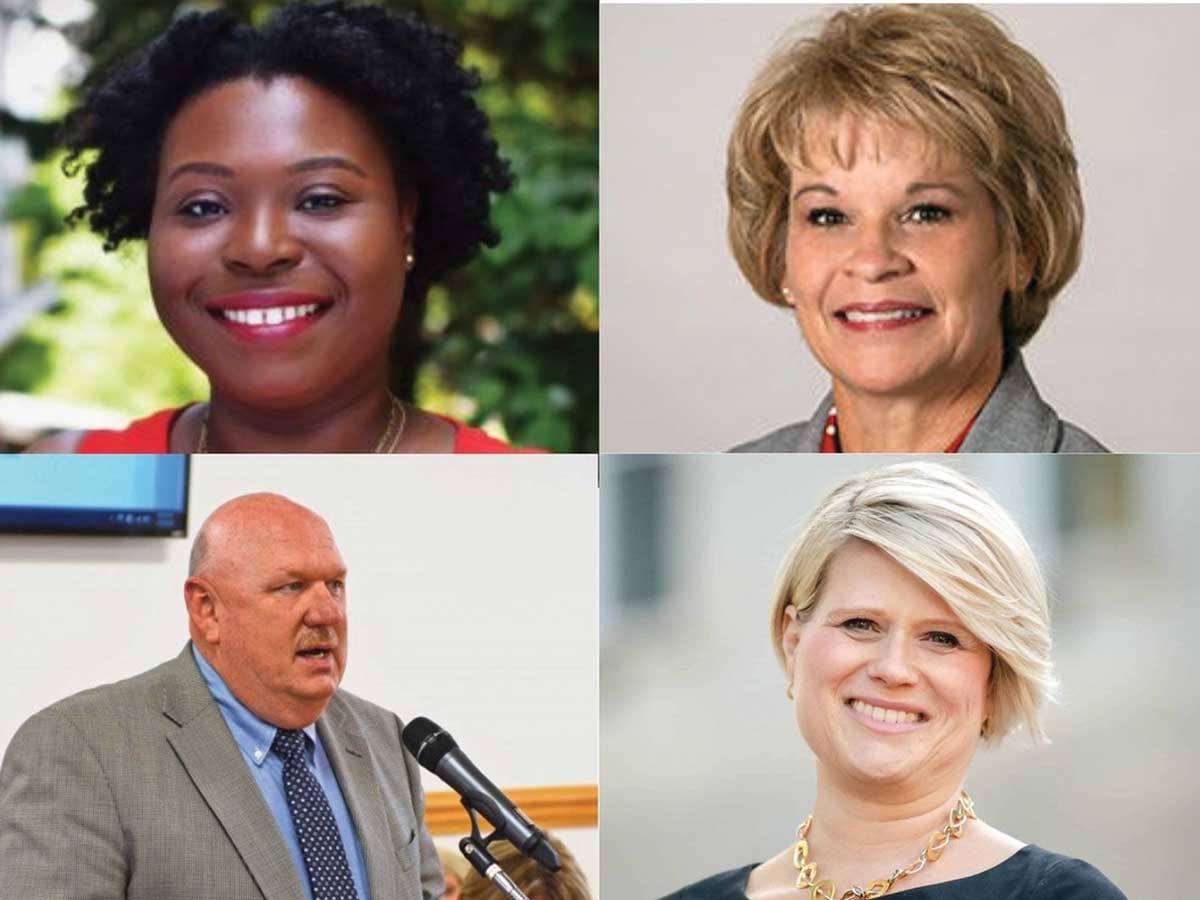State budget includes teacher pay increase, COVID relief
 Clockwise from top left: Tamika Walker Kelley, Dr. Dana Ayers, Dr. Catherine Truitt, Dr. Bill Nolte.
Clockwise from top left: Tamika Walker Kelley, Dr. Dana Ayers, Dr. Catherine Truitt, Dr. Bill Nolte.
After years of working to provide public education during a pandemic without pay raises, or a state budget, public schools in North Carolina will once again operate with a state budget in place after it was signed Nov. 18 by North Carolina Gov. Roy Cooper.
The budget does address many important issues like teacher and support staff pay increases, COVID relief and a hold harmless provision to fund schools at pre-pandemic enrollment levels. However, it does not fully fund the Leandro remedial plan — a seven-year plan for North Carolina Public Schools intended to increase funding for low wealth school districts, providing equal education for students in less affluent parts of the state.
“This budget moves North Carolina forward in important ways. Funding for high speed internet, our universities and community colleges, clean air and drinking water and desperately needed pay increases for teachers and state employees are all critical for our state to emerge from this pandemic stronger than ever. I will continue to fight for progress where this budget falls short but believe that, on balance, it is an important step in the right direction,” said Cooper.
In total, the budget allots $25.9 billion for public education in fiscal year 2021-22 and $27 billion in FY 2022-23. Of that, $10.6 billion will go to K-12 education in FY 2021-22 and $10.9 billion in FY 2022-23. The NC Education Lottery will provide $528 million to the needs based public school capitol building fund and $80 million to the newly created repair and renovations fund.
“We’ve not had a completely revised state budget in three years. And so to have one is very good because we know where we stand, not only on pay, but on things like staff development for teachers or money to buy paper and pencils and computers and all those things. So it’s really good to have a budget,” said Superintendent of Haywood County Schools Dr. Bill Nolte.
Related Items
Pay Increases
The new budget accounts for an average 5% pay raise for teachers, and most other state employees, over the next two years. Principals will receive a 2.5% pay raise over the next two years. For school support staff, the minimum salary will be raised to $15 an hour.
“I think that there are a lot of very positive aspects to be included in the new budget. Obviously, our teaching staff, our support staff, our non-certified staff — they very much deserve to get a pay increase,” said Jackson County Schools Superintendent Dr. Dana Ayers. “It’s a hard situation to be in because they haven’t received one for such a long, long time. So obviously I believe it should be much greater for the job that all of our educators are doing no matter what their role, but it feels good to know that this state is finally seeing what the teachers are doing for our families and for our students and know that they are going to be compensated, no matter how small it feels right now, it does feel good to be recognized.”
In addition to pay raises, most teachers in North Carolina will receive supplements. Most districts in North Carolina offer supplements to the state and federal salaries, but counties with lower property tax base than wealthier counties aren’t able to offer as much. The idea is that state-funded salary supplements would help make less-wealthy districts more competitive.
The only counties in the state not receiving a state-funded salary supplement are Buncombe, Durham, Guilford, Mecklenburg and Wake. Haywood County will receive $971 in teacher supplemental assistance per state funded teacher, Jackson will receive $930, Macon will receive $2,737 and Swain will receive $2,953. With supplements included, average teacher pay in North Carolina will rise by 6.7%.
Nolte noted some concern over where the money for pay raises would come from. Districts do not receive money from the state to pay for local and federal employees.
“The negative part of the budget is, we anticipate that in order to pay our local and federal people the same amount as our state people, we will have to cut a number of the local lines that are not salary,” he said.
While Nolte said he is very happy for all of the employees to be getting raises, he is concerned that spending that money on employees will mean less money for things like school supplies and materials.
“School and district staff worked tirelessly throughout the pandemic and their efforts have been nothing short of remarkable. I’m pleased to see salary increases for teachers, school support staff, and principals in addition to the bonus options for educators and the newly-established Supplementary Fund for low-wealth districts, enabling them to increase teacher pay and retain staff,” said State Superintendent of Public Instruction Catherine Truitt. “Additional funding in this budget allows us to progress in hiring more school psychologists, maintain statewide literacy training efforts and address the workforce demands of today and the future with a new computer science division at the department.”
Hold Harmless Clause
The new budget includes a hold harmless clause, a measure enacted for schools last year, even when there was no state budget. This stipulation was put into place due to an across-the-board enrollment drop in public schools during the Coronavirus Pandemic. For at least the next two fiscal years, the state will fund all public schools according to their pre-pandemic enrollment levels, instead of at lower levels according to actual enrollment numbers.
This will be helpful for districts across the state who, like Haywood County Schools, have seen significant enrollment drops. According to Nolte, Haywood County Schools has lost at least 400 students throughout the pandemic years. Nolte also noted the difficulty schools have had in retaining teachers during the pandemic years.
“We are thankful. At some point in time, the hold harmless clause will have to stop. It [Coronavirus Pandemic] will stabilize or diminish and more people will come back across the nation, or they won’t,” said Nolte. “As a taxpayer, I understand that it’s good to give waivers and consideration, take extraordinary steps to keep people’s nose above water during a pandemic. We’re very thankful.”
In Jackson County, Superintendent Dr. Dana Ayers says that Jackson County Public Schools has not seen a significant drop in enrollment, losing only about 100 students. However, Ayers noted that for districts around the state, pre-pandemic enrollment funding levels will be helpful.
Voucher Expansion
The budget expands the availability of who is able to receive taxpayer funding to attend private schools and increases the amount of money they can receive. The state currently provides up to $4,200 per student for middle- and lower-income families who use Opportunity Scholarships to attend private schools. The budget changes the voucher to 90% of the total amount the state spends each year per public school student. The estimated new annual voucher amount is $5,850.
In addition, the budget raises the income eligibility to include families making up to 175% of the amount that qualifies someone for the free-or-reduced-priced lunch program — $85,794 for a family of four. The previous eligibility cap was 150%.
There is also an additional $15 million allocated each year to the voucher program. For FY 2023-24 this will equal $120.5 million for the program. Opponents to the program say it is unconstitutional because it provides public funding to schools that discriminate against students based on religion.
“Obviously, I would want public money to go for public schools,” said Ayers. “But I do understand that different families choose different things for different reasons. And so I respect that for people. As a parent myself too, I understand that, but I have to always continue thinking about advocating for public schools and for the funding we need to make sure that we are taking care of our students and allowing for them to have all the opportunities that we can give them with the funding that we have.”
Leandro Funding
The Leandro case began in 1994 when families in five low-wealth school districts in North Carolina Counties — Hoke, Halifax, Robeson, Vance and Cumberland — sued the state. They argued that their children were not receiving the same level of education as those of higher-income counties.
In 1997, the State Supreme Court sided with the families and ruled that the North Carolina Constitution guarantees every child in the state “an opportunity to receive a sound basic education,” and that the state was not meeting that standard. In 2004, the court specified that the state was not providing adequate education to poor children.
In June, a North Carolina Judge approved a seven-year plan to address the issue, to which the State Board of Education, the plaintiffs and the Cooper administration agreed. The $5.6 billion plan includes a 5% pay raise for teachers, more funding for low-wealth school districts and expanding the state’s pre-K program. The new state budget for North Carolina falls somewhere between $700 and $900 million short of the approved plan.
“There are some wins in this budget, which include an increased minimum wage for our support staff and a hold harmless clause that will help provide stability for local school district budgets during this turbulent period. But considering what could have been done, the bare minimum is not enough. And so yes, we are disappointed in this outcome,” said NCAE President Tamika Walker Kelly. “There has been some progress made for public schools, but we must keep our eyes forward on the needs that remain. We will continue to do our advocacy work together for North Carolina students and educators because every child in this state, regardless of their race, background or zip code, deserve a high-quality public education that gives them the chance to pursue their dream.”
According to data from the Department of Public Instruction from FY 2018-19, Swain County is the only low-wealth district in The Smoky Mountain News’s four county coverage area.
More detailed budget information for individual districts will be available in the coming weeks.









